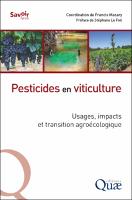Pesticides en viticulture
Usages, impacts et transition agroécologique
Abstract
The phytosanitary protection of vineyards raises many questions of interest to winegrowers. What diseases and pests attack vines in the different producing countries? What vineyard management practices ensure phytosanitary protection? What are the consequences of the use of organic and inorganic pesticides in terms of environmental risks on terrestrial and aquatic ecosystems? What are the reactions of biological species to the impacts of pesticides? In order to provide the best possible answers to these questions, researchers from various disciplines (agronomists, agro-ecologists, agro-economists, environmental chemists, hydrobiologists, ecologists, ecotoxicologists) have joined forces to provide scientific explanations, backed up by their experiences on a common study site. The authors also explore strategies for changing winegrowing systems to drastically reduce the current phytosanitary pressure of pesticides on ecosystems and biota. Finally, they examine the action of public policies to support these strategies. Each chapter is accompanied by the testimony of a socio-professional actor or scientific expert, in order to establish a close relationship between the needs in the field and the research conducted. This book is mainly intended for managers of agricultural and environmental services, teachers and students, professionals in the field: wine growers and advisors, river technicians, etc., but also for anyone interested in the issue of pesticides, particularly in viticulture.
Keywords
organic farming; agronomy; algae; contamination; river; sustainable development; water; seawater; freshwater; ecology; ecosystem; environment; pest control; pesticide; public policy; pollution; plant production; soil; wineDOI
10.35690/978-2-7592-3601-5ISBN
9782759236008, 9782759236015, 9782759236022, 9782759236008Publisher
éditions QuaePublication date and place
2022Classification
Food and beverage technology


 Download
Download